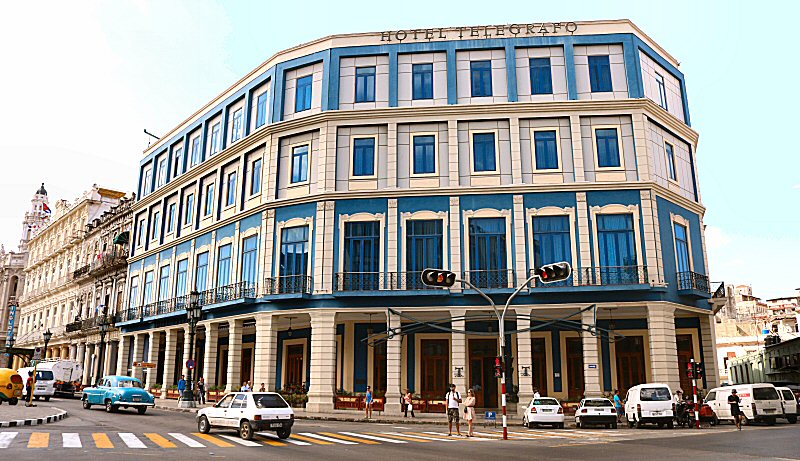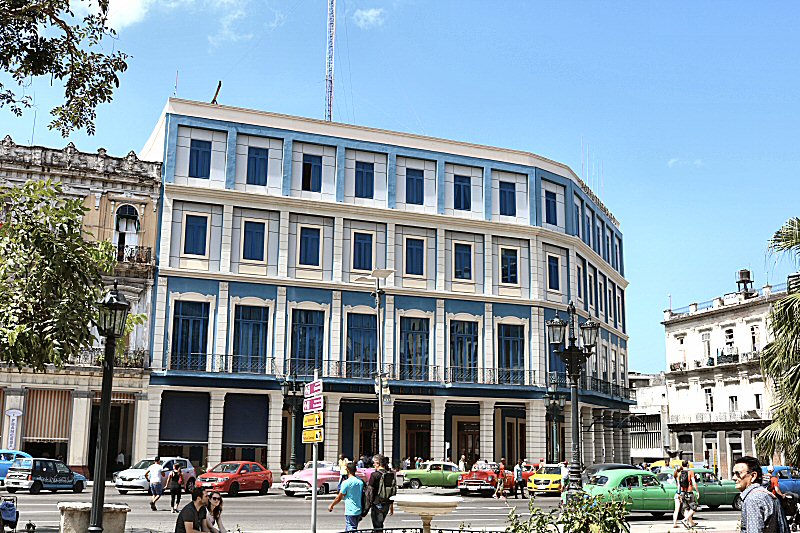
The Hotel Telégrafo is located on the
Paseo de Martí (former Paseo de Prado) #406, where it intersects
with the Neptuno street; a corner known in Havana simply as
Prado y Neptuno.

The Old Havana was surrounded by city
walls for the safety reasons during the second half of the 18th
century, but by passage of time the city grew, particularly in
the direction of north, and the intramural public spaces were
not sufficient anymore for the recreation and social life of the
habeneros, so that it became necessary to overcome the limits
imposed by the walls. According to the urbanization program, the
first goal was to build a great extramural promenade like in
Paris that would be one kilometer long, extending between two
doors of the city walls.
Thus, the construction of the current
Paseo de Martí, the first avenue located outside the old city
walls, began in 1772, but the Captain General Miguel Tacón y
Rosique (1834-1838), the first great urban planner of the city,
converted the mall into an avenue with two rows of trees in its
beginnings, and extended it to the coast (to that what is
Malecón today). Soon it became the promenade of the Havana
society of the time that was eager to have a place for leisure
and walking, particularly at dusk. The Governor Tacón, inspired
by the Las Ramblas in Barcelona, changed the rural character of
the Alameda de Extramuros by widening the road and favoring the
construction of a series of public buildings nearby, such as the
Teatro Tacón and the Real Cárcel. With the inauguration of the
Teatro Tacón in 1838, nowadays Gran Teatro de la Habana Alicia
Alanso, and some cafés, such as the Café Escauriza (opened in
1843) with El Louvre ice cream shop in its upper floors, the
Alameda de Extramuros (current Paseo de Martí) increased in
importance among the Havana society and it became the center of
the social life of Havana of the time.
The new hotel was founded in 1860 (1858-1863) and received the name of Hotel Telégrafo. It got this name, because it served as the country’s first telegraph station. In 1888 it moved to its current building at the beginning of the Paseo de Isable II (current Paseo de Martí). When Alejandro López died in 1886, he left all his property including the hotel to his son Román Carlos López y Hoyos, but the hotel flourished during the time of Pilar Samoana and Guillermo del Toro, a merchant couple that was very well known in the hotel industry. When Pilar Samoana bought the hotel in 1895, she charged his husband with the administration of the hotel. They completely renovated the hotel, adding another story to the original building. They set new standards in the hotel management that converted the Hotel Telégrafo into one of eleven best hotels in Latin America. The hotel with its facilities became the meeting point of the Havana aristocracy during the first decades of the 20th century. The telephones in the rooms and on the tables in the restaurant on request, made the hotel a favorite place for politicians and the businessmen. The hotel owned the only telegraph line of the island; the hotel took its name from this feature.
In due course, the splendor
of the hotel ceased, so that a complete restoration became
necessary in 1911. Gradually
the former baroque and colonial style buildings were replaced by
the large and lavish neoclassical buildings on either side
throughout the Paseo de Martí that made the localization of the
hotel more appealing.
The restaurant of the hotel,
specialized in Cuban and international cousine, gives access to
the Acera del Louvre (Sidewalk of the Louvre). The part of the
Paseo de Martí between the San Rafael and the San Miguel streets
that runs along the hotel was called so, and particularly the corner of Paseo de
Prado and the San Rafael street was a meeting place of the
young native people with ideals of independence in 1890’s. The
sidewalk received its name from El Louvre coffee shop (current
Grand Cafe el Louvre) and the young people that had high
cultural level in the majority, was called as “Boys of the
Sidewalk of Louvre”. In the lobby you can see
several pieces of ancient telegraphs and a section of the first
underwater cable that was used to establish telegraph communication
between Florida and Havana in 1880s.
The Hotel Telégrafo is the
oldest hotel in Cuba. It had also
prestigious guests, such as Chin Lan Pin (Chinese Mandarin),
Heinrich Schliemann (German archeologist that worked in the
excavations of the ancient city Troy in Turkey), Alfredo
Sosabravo (Cuban painter, ceramist, engraver), Conchita Supervia
(Spanish lyric mezzo-soprano) and El Caballero de París (the
Knight of Paris; street person well known in Havana in 1950’s).
The Hotel Telégrafo is
managed by Habaguanex SA.

